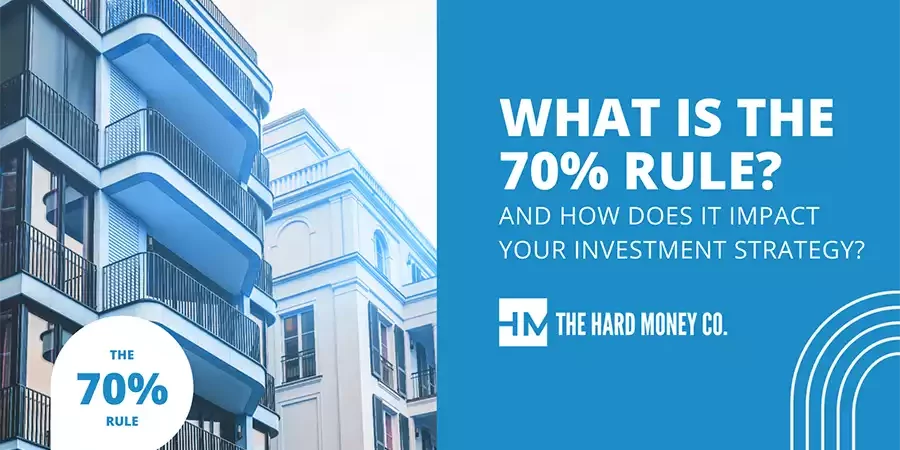What is the 70% Rule and Why is it important for house flipping?
If you've spent any amount of time researching fix and flips, you've likely come across the 70% rule before. The concept for flips is simple enough; acquire a property for a low enough price that you can generate a substantial return on a resale. Paying too much upfront can doom your project from the start. But how do you know what price point to target? That's where the 70% rule comes into play.
As a guideline, it's one of the foundational principles in house flipping, but it's important to remember that it is just a guideline. Investors will still need to put in the leg work to make sure their evaluation of the property is complete. That said, if you've done your homework and are sticking to the 70% rule, you should set yourself up well for success.
What is the 70% rule?
Plainly stated, the 70% rule is that you should never spend more than 70% of a property's After Repair Value (ARV) on its acquisition. This prevents investors from overextending themselves early in the project, gives them a buffer to tolerate unforeseen circumstances, and, most importantly, allows them to generate profit in the end.
Your anticipated after repair value multiplied by 0.70 (less your repair costs) should be the absolute most you pay on a property.
The very simple equation looks like this:
(After Repair Value (ARV) x .70 ) - Repair Costs > Purchase Price
One of the primary benefits of the 70% Rule is that it has value throughout the lifespan of the project, from your initial research phase through completion. Each step of the way requires a slightly more detailed approach, but the underlying valuation methodology doesn't change.
At the beginning of your project, you can use the rule to loosely identify potential properties by working through the inverse of the rule. Establish what your budget might look like and work backward to see what a target ARV might look like. From there you can look into different markets to find potential comps. This gives you a different perspective on properties than someone who is simply pouring through the listing sites. Without ever having to do the difficult work of evaluating a property, you can create a list of assets that may have some potential.
Investors can then begin to examine the details more closely. Drafting a detailed plan with this framework in mind can help you maintain perspective as the costs pile up. It will also help ensure that you are accounting for all inputs while still keeping future profitability at the forefront of your strategy.
How do I determine ARV?
One of the key components of the 70% rule is having an accurate assessment of the property's potential resale value. This is commonly referred to as After Repair Value (ARV), or the price of the asset after all planned renovations have been made. This is particularly important in house flipping as the focus is almost entirely on distressed assets; homes that have some inherent problem that needs to be resolved before it’s a realistic option for occupancy. The range of issues can be quite large, which is why it's so important to account for the costs of repairs in your 70% rule calculation. A home that needs new carpet and paint is a decidedly smaller investment than a similarly sized home that has major structural problems.
Getting your property up to par is only half the battle, though. From there you will have to determine what a comparable property would sell for in that market. Look at other properties within 1-2 miles of your asset and see what they have sold for (or are listed for) within a reasonably close time period. Pay attention to property attributes including bedrooms, baths, and total square footage. These will all correlate with the price you can fetch on the open market.
Be aware that the flourishes and amenities you are considering adding may not be reflected in the price point. A lot of the bells and whistles that you find in fixes and flips may improve the marketability of the property without adding dollars to your profit margin. Some of the most successful flippers avoid these entirely and focus on the basics. This allows them to keep their repair budget low without sacrificing much on the ARV. This is one of the most effective methods to stay within the 70% rule.
Conservative Numbers Only
Flipping a house can be exciting and when the primary motivation for a project is dollar signs, it can be easy to get carried away with your projections. While it's okay to be internally optimistic about the potential success of your project, your strategy should seek to be as conservative as possible. This means ballooning the projections for your repair budget and timeline by as much as 30%. While it's cliché to say, "expect the unexpected", circumstances will arise that have the potential to derail your investment. The more buffer room you build in, the better off you will be when problems present themselves.
Similarly, you should curb your optimism about the potential resale price. Anticipating a price that is too high will only hurt you as an investor. It is much better to set the bar at an attainable level and clear it than it is to set the bar high and fall short. While you may hit your targets once or twice with optimistic projects, eventually you will fall short your pockets will suffer. Investors that maintain conservative expectations, can go an entire career without significant losses on a project.
Choosing realistic numbers will improve the efficacy of the 70% rule. If you've done the research, used conservative estimates, and are sticking to the fundamentals of fix and flip projects, you should absolutely find success with your investment.
The 70% Rule is STILL just a guideline
No matter how confident you are in your analysis, at the end of the day, the 70% rule should be nothing more than a guideline. You can likely think of 10 circumstances off the top of your head that would render the rule obsolete, and you're probably right. For instance, our most recent housing market vaulted the price of acquiring a property. Most sellers wouldn't even entertain the prospect of selling the house for 70% of its potential. In situations like this, it's okay to proceed, so long as you have the complete understanding that your risk has increased and your margin of error is significantly smaller.
Maybe you're a savvy, volume investor and you can consistently execute deals at 85%. That's okay too! Your experience outweighs an arbitrary rule in the industry, but there's a reason conventional wisdom is conventional. Jerry Norton, a serial flipper and successful entrepreneur, is extremely strict about his use of 70%. With hundreds of flips under his belt, he still uses this number for all of his transactions.
Final Word
The 70% rule is an essential point of reference for your investment toolbox. In every deal you undergo, you should be considering this concept in some capacity. The specific 70% number is not the end-all, be-all. Your personal preference could be 80% or 60% depending on your experience. Here at The Hard Money Co., we will only lend up to 65% of the ARV to ensure that our investors have room to apply the 70% rule when working with us.
But even with the importance of the 70% rule, know that it is still just a guideline. With changing environmental factors and a limitless variety of obstacles and opportunities, you may need to change course. With a comprehensive understanding of the concept, though, you will be well-positioned for success.


